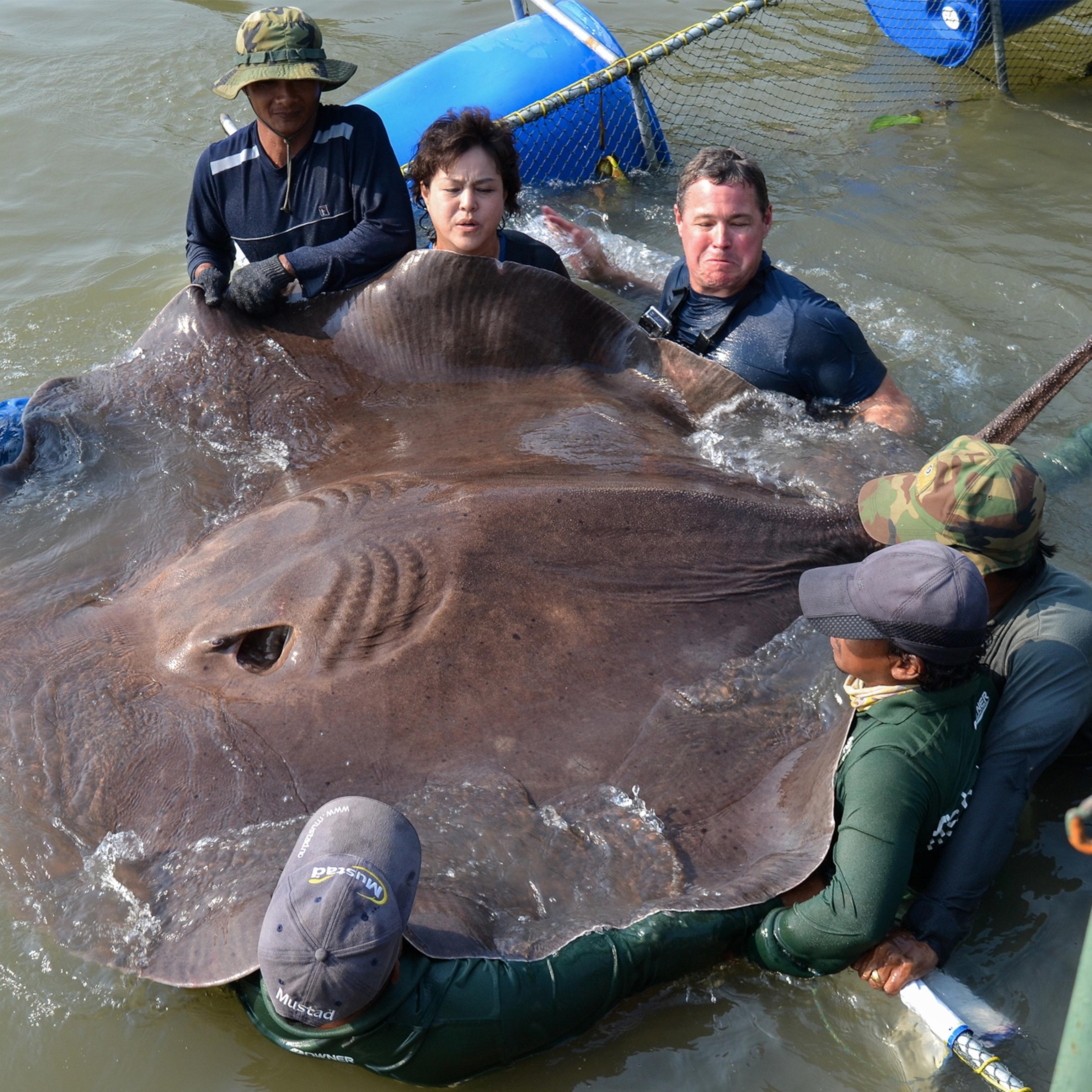Stingrays can be dangerous creatures to encounter in the wild, but can they actually kill you? The answer is yes, although it is extremely rare.
To start, stingrays are generally considered docile creatures that only attack when provoked or threatened. However, if one of these animals is startled or threatened by a human, they may respond with a defensive strike from their tail spines. These spines contain venom which can cause intense pain and swelling in humans. While this venom may be unpleasant, it is generally not fatal to humans unless the person has a severe allergy to it.
The more serious danger comes from the puncture wound itself. If the tail spine pierces a large blood vessel or an organ such as the heart, lung or bowel, it can cause severe internal bleeding and potentially death. Death resulting from a stingray injury is extremely rare and has only been reported 17 times worldwide.
The most famous example of someone dying from a stingray injury comes from Steve Irwin’s 2006 death in Australia. He was filming a short-tailed stingray with an approximate span of two meters (6.5 ft) when he approached it from behind and was struck by its barb which pierced his heart and ultimately led to his death due to blood loss.
In conclusion, while stingrays are mostly harmless creatures that should be respected, their barbed tails can pose a serious threat if you find yourself too close for comfort. To avoid any potential danger always observe these animals from a distance and never approach them unless you know what you’re ding – like Steve Irwin did!
The Dangers of Stepping on a Stingray
Stepping on a stingray can be dangerous and potentially fatal, but it is very rare. The stingray has a sharp, venomous spine near its tail which it uses to defend itself if it feels threatened. If the spine penetrates deeply enough into the skin, it can cause serious damage to organs and blood vessels, leading to death. Additionally, some people may have an allergic reaction to the venom and suffer from anaphylaxis. Therefore, it is best to be aware of your surroundings in shallow water and avoid stepping on any marine life.

Source: nationalgeographic.com
Can You Survive a Stingray Sting?
Yes, it is possible to survive a stingray injury. The most important thing is to immediately take steps to provide first aid care. First, the area around the wound should be washed with soap and water or an antiseptic solution. If the wound is bleeding heavily, direct pressure should be applied to stop the bleeding. Ice can also be applied to reduce pain and swelling. Medical attention should be sought as soon as possible for further treatment, such as antibiotics and/or tetanus shots. In some cases, stitches may be necessary if the wound is deep. With proper treatment, recovery from a stingray injury can usualy occur without any long-term effects.
Frequency of Death by Stingray
Death by stingray is incredibly rare. In fact, since records began, there have only been 17 confirmed deaths as a result of stingray attacks worldwide. This shows that it is highly unlikely for a person to die from a stingray attack and that these creatures are usually quite docile. Stingrays will usually only attack when they feel threatened or provoked, making it even more rare for them to cause fatal injuries to humans.
The Tragic Death of Steve Irwin: How a Stingray Caused His Demise
Steve Irwin, the famous Australian wildlife conservationist, was killed by a short-tail stingray while swimming in chest-deep water. He had been attempting to film the ray when it suddenly turned and pierced his chest with its venomous barb. The barbed stinger punctured his heart, causing him to quickly bleed to death. Initially, it was thought that he had only suffered a punctured lung, but the injury was much more serious. This unfortunate incident serves as a reminder of how dangerous some of the creatures we share our planet with can be.
The Sensation of Being Stung by a Stingray
A stingray stab can cause intense, localized pain that radiates outward from the wound. It is often described as a burning or stabbing sensation, similar to a bee sting or a needle prick. The area may become swollen and discolored, turning blue or red. In some cases, it may even become numb and tingly due to nerve damage caused by the venom. There is usually no lasting damage, but it can be very painful and disorienting in the moment.

Source: en.wikipedia.org
Are Stingray Deaths Uncommon?
Yes, stingray deaths are incredibly rare. In fact, since records began, there have only been 17 recorded deaths caused by stingrays worldwide. The majority of these cases were caused by a person accidentally stepping on a stingray while in the water. Stingrays can be dangerous if they feel threatened, but they usually try to avoid contact with humans. Most of the time, injuries caused by stingrays are minor and can be treated with first aid or antibiotics.
Does Touching Stingrays Cause Harm?
No, it does not hurt stingrays to be touched by humans. In fact, research conducted with nearly 60 stingrays at the Shedd Aquarium in Chicago has shown that these animals do not suffer any negative effects from human interaction. According to Bill Van Bonn, Shedd’s vice president of animal health, “We can never know for certain if an animal is experiencing discomfort or distress, and we know the animal’s not going to tell us.” This study indicated that the gentle touching of a stingray’s skin does not cause any harm or discomfort and can actually be beneficial to the animal’s welfare.
Swimming Safely with Stingrays
Swimming with stingrays can be a thrilling experience, but it is important to remember that these animals are wild and shoud be respected. It’s best to swim with stingrays in an organized tour, as the guides will know how to safely interact with them, and they will also provide you with the necessary protective gear. If you do decide to swim with stingrays without a guide, take some precautions like avoiding any sudden movements or loud noises. Make sure you give them plenty of space and don’t touch them—stingray barbs can cause serious injury if mishandled. Lastly, never attempt to swim over a stingray as this has been known to cause fatal injuries. With these safety tips in mind, it is possible to enjoy swimming with stingrays in a safe and responsible way.
What To Do If A Stingray Approaches You
If a stingray approaches you, it is important to remain calm and keep your distance. Make sure not to make any sudden movements or touch the stingray. Gently back away and avoid making loud noises that may startle the animal. If you are in the water, gently shuffle your feet on the sandy bottom as this will alert the stingray of your presence and it will swim away from you.

Source: akronzoo.org
The Tragic Death of Steve Irwin from a Stingray
Steve Irwin, the beloved Australian wildlife expert also known as ‘The Crocodile Hunter’, tragically died in 2006 at Australia’s Great Barrier Reef after being fatally stung by a large stingray. The camera crew that was accompanying Irwin at the time captured the heartbreaking moment when the stingray barb pierced through his chest and killed him. His death shocked the world, and his memory is still revered today.
Are Stingrays Friendly?
Stingrays are generally known to be quite friendly and curious creatures. While they may not actively seek out human contact, they will often approach divers and snorkelers in the wild, seemingly out of curiosity. They are not aggressive animals and will usually swim away if they feel threatened or uncomfortable. It is important for people to remember that stingrays need their personal space and should never be touched or harassed.
Annual Deaths Caused by Stingrays
On average, only one or two people are killed by stingrays each year worldwide. However, this is likely an underestimation of the true number of fatalities, since some cases may go unreported or be misattributed to other causes. Additionally, there are a great many more non-fatal stingray attacks each year in shallow waters around the world. These typically involve unsuspecting individuals who inadvertently step on the rays while they are nestled in the sand, trying to avoid predators.
The Dangers of Stingrays: Can They Impale You?
Yes, stingrays can impale a person if they are disturbed or perceive a threat. The stingray has a long, sharp spine that is covered in small barbs. When the spine penetrates the skin, these barbs catch on the surface of the skin and make it difficult to remove without doing further damage. In some cases, the spine can even penetrate deep enough to cause internal injuries. It is important to be aware of your surroundings when swimming in areas where stingrays may be present and take care not to disturb them.

Source: britannica.com
Can Stingrays Kill Sharks?
Yes, it is possible for a stingray to kill a shark. Stingrays have natural defense mechanisms that can be used to ward off predators, including venomous spines located near their tails which are used to attack or deter predators. Sharks are often the victims of stingray attacks and in some cases, the stingray’s venomous barb can penetrate the shark’s eye or brain and cause death. In this case, the juvenile Mako shark found on a beach in Mexico appears to have succumbed to an attack from a stingray.
Conclusion
In conclusion, it is extremely rare for a stingray to cause death. Most stingray injuries are minor and can be treated with first aid. However, if the stingray’s spine penetrates a major organ, like the heart or lungs, death is possible. Additionally, some people may have an allergic reaction to the venom of a stingray which could lead to anaphylaxis and death. While stingrays are considered docile creatures, it is still important to exercise caution when approaching them in order to avoid any potential danger.
